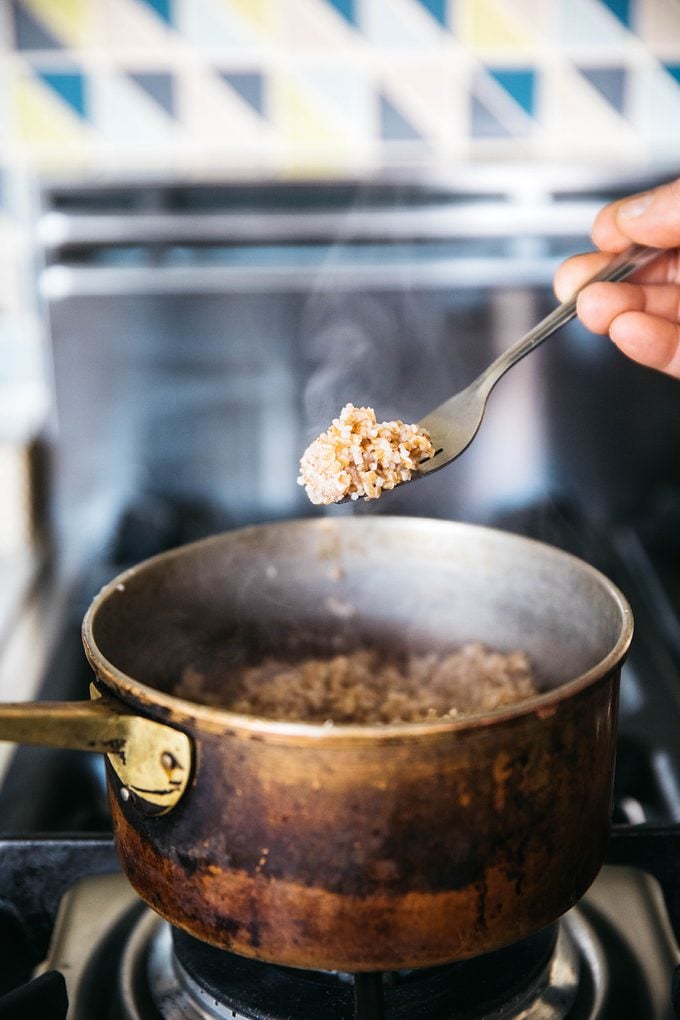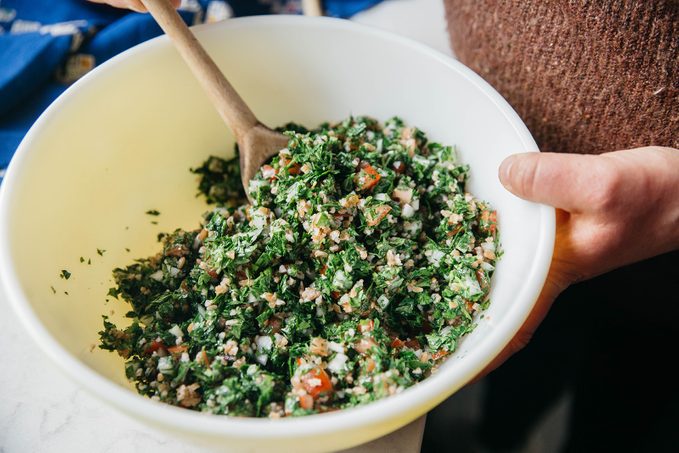What is tabouli, you ask? This easy-to-make grain salad is about to earn a permanent place in your recipe rolodex.

What Is Tabouli and How Do I Make It?

When you hear the word salad, you probably think of a classic green leaf lettuce salad. Maybe there are some croutons or shaved carrots, probably a simple vinaigrette or creamy dressing. This is the kind of salad that sits on millions of dinner tables across the country every night of the week.
I love a classic green salad, and we have them all the time, but I also follow in my mom’s footsteps by changing up our salad options often. This introduces different colors, textures and flavors, and there are endless options with so many types of salads to choose from. What’s more, simply changing up a salad can transport us to different parts of the world from the confines of our own home.
I like to make a classic tabouli, a parsley and grain salad that pairs well with Middle Eastern and Mediterranean foods, and offers a refreshing way to eat your vegetables.
What Is Tabouli?
Tabouli is a staple in Middle Eastern cuisine. This simple salad is composed mainly of parsley and bulgur—heavy on the parsley—and also tends to have mint, tomatoes, some kind of onion, lemon juice, olive oil and seasoning. It most likely hails originally from Lebanon and Syria, and is also popular in Palestine, Egypt, Israel and beyond. Recipes will vary according to regional and family traditions, particularly in regards to the herb-to-grain ratio.
But at its heart, tabouli is a celebration of parsley. This humble herb is the star. The co-star of the show is bulgur. Also known as bulgur wheat, this grain is made of cracked wheat berries. It comes parboiled so it cooks quickly, it’s a great source of protein and it’s a whole grain that is packed with nutrients. You’ll find a variety of spellings for tabouli, including tabouleh, tabbouleh or tabbouli. However you spell it, you’re in for a refreshing and nutritious meal.
How to Make Tabouli
This recipe for tabouli is from Taste of Home readers Michael and Mathil Chebat.
Ingredients
- 1/4 cup bulgur
- 3 bunches fresh parsley, minced (about 2 cups)
- 3 large tomatoes, finely chopped
- 1 small onion, finely chopped
- 1/4 cup lemon juice
- 1/4 cup olive oil
- 5 fresh mint leaves, minced
- 1/2 teaspoon salt
- 1/2 teaspoon pepper
- 1/4 teaspoon cayenne pepper
Directions
Step 1: Prepare your bulgur

Bulgur can be cooked either on the stovetop or via the soaking method. Since it comes in several grain sizes, from fine to extra coarse, you can generally follow the instructions on the bag. But my rule is a one to two grain to water ratio, with the following methods:
- To cook on the stovetop: Combine ¼ cup bulgur with ½ cup of water and a pinch of salt, and bring to a boil. Reduce to a simmer, cover and cook for 10 to 12 minutes until the grain has softened to al dente. Remove from heat and let sit covered for 2 minutes. If there’s extra water, strain through a fine-mesh strainer.
- To cook by soaking: In a medium bowl, pour ½ cup of boiling water over ¼ cup bulgur and a pinch of salt. Mix well, cover and let sit for 30 minutes until completely absorbed.
Once the bulgur is fully cooked, run a fork through it to fluff it up. Leave uncovered and allow to cool while preparing the remaining ingredients.
Step 2: Pick your parsley

The most time-consuming part of this preparation is picking your parsley. But here are two tricks: First, don’t worry if there’s a small stem here or there, that will all get absorbed in the dish and no one will be the wiser. Second, I pick parsley quickly by holding the thick end of the stem with one hand, and with my other hand, I pinch my fingers around the stem at the bottom leaves and pull upward so the leaves come off in a bunch.
Pick all your parsley and set it aside in a medium bowl.
Step 3: Chop your vegetables

Chop your parsley finely and return to the bowl. Chop the mint, tomatoes and onion and add to the parsley. Add your lemon juice, olive oil and spices. At this point, all the ingredients except the bulgur should be in the bowl.
Step 4: Add bulgur to finish

Add cooled bulgur to the bowl of ingredients and toss together gently. Taste for seasoning, adding more salt or lemon juice as needed. You can eat fresh from the bowl, or chill before serving. This tabouli can be prepared in advance, as the flavors will only deepen and come together even better.
Tabouli Variations
There are lots of ways to adapt tabouli to fit your diet, your food restrictions or even just the ingredients you have on hand. Here are a few that I recommend:
- I’m a big fan of what I call a “winter tabouli.” Where I live, tomatoes are only in season for a couple of months out of the year, so I substitute roasted beets for the tomatoes and keep everything else the same. Just beware that if you use red beets they will stain the rest of the salad red!
- For folks with gluten intolerance, an easy variation is a quinoa tabouli. Just sub in cooked quinoa for the bulgur. It’s still delicious and nutritious. You can also add even more variety using this Quinoa Tabbouleh recipe that incorporates black beans and cucumbers.
- If you don’t have the exact ingredients in your fridge, a delicious tabouli can still be made! You can add dill or cilantro to your parsley to bulk it up. You can substitute scallions or shallots for the onion. You can use pomegranate seeds or sun-dried tomatoes instead of fresh tomatoes. And there are tons of grain options—instead of bulgur try Israeli couscous, wheat berries, barley, farro or even cauliflower rice. The varieties are endless!
Tips for Making Tabouli
- Tabouli can get watery three ways: the parsley, the tomatoes and the bulgur. Prevent your tabouli from getting watery by using a sharp knife to cut your parsley (and don’t over chop it), not adding any excess tomato water and straining the chopped tomatoes before adding them, and making sure to strain your bulgur if there’s excess liquid.
- Let your flavors marinate! Tabouli is at its best after it sits for a few minutes (or even overnight) to allow the flavors to meld together.
- Tabouli goes great with most Mediterranean and Middle Eastern foods. Have a mezze meal by pairing it with hummus, tahini and a watermelon salad. Or serve tabouli with a delicious protein like Savory Rubbed Roast Chicken, Spicy Lemon Chicken Kabobs or this special Pear and Pomegranate Lamb Tagine. It’s also a great snack all on its own or with some pita bread.
- Tabouli is always served cold or room temperature, it’s not a salad you’ll want to heat up.
- Store your tabouli in a container in the fridge. It will stay good for a week, but will be best in the first couple of days.
